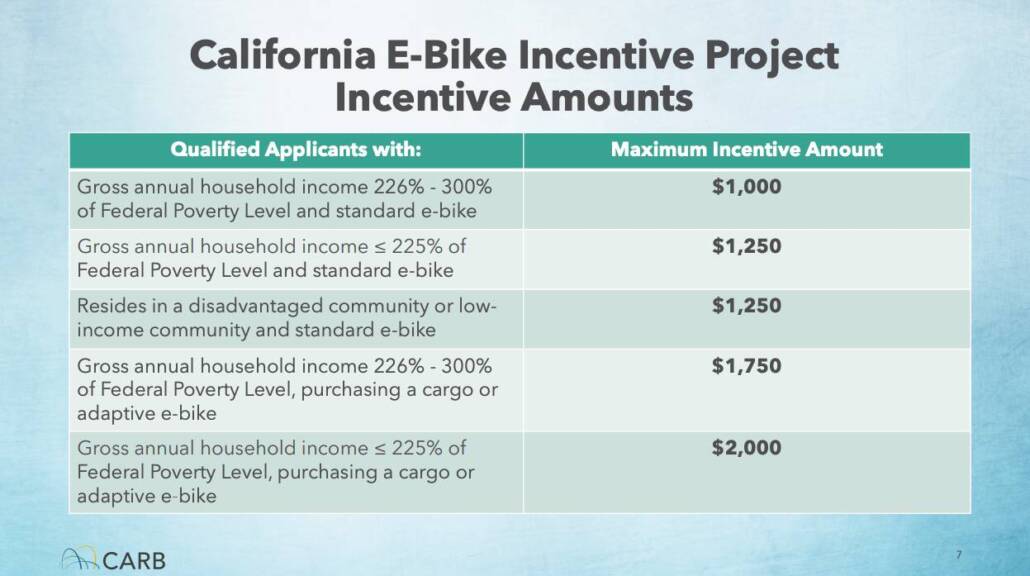Final E-Bike Incentive Work Group Reveals New Details About the Program
On May 1, 2024, the California Air Resources Board (CARB) held what we hope is the last work group meeting about the California E-Bike Incentive Project before a launch date is announced and the first application window opens. The meeting was dominated by bike manufacturers and retailers and largely centered around the new program requirement that all eligible e-bikes have UL- or EN-certified batteries.
From the meeting, combined with a session on the program’s soft launch and follow-up questions to the program administrator and CARB, the shape of the program is beginning to emerge. Here’s what we know now.
Support for battery certification
The recently added requirement that bikes eligible for vouchers have batteries certified to UL or EN (European) standards sparked passionate responses on both sides. While many of the speakers at the work group, including a number of bike retailers, were supportive, some bike manufacturers were upset by the change so close to implementation.
Two manufacturers noted the high cost and long timeline to get UL certification. One said his company had taken other steps to comply with the program requirements so its bikes could qualify for vouchers and was angry the new requirement meant his brand wouldn’t be able to participate in the program.
It seems that battery certification is baked in, especially with SB 1271 working its way through the legislature. The bill, which CalBike supports, will require all e-bikes sold in California to have certified batteries. Low-quality or after-market batteries have caused several structure fires in New York because they can overheat and catch fire during charging, so the requirement for higher-quality batteries will help ensure e-bike safety.
Higher incentive amounts
The work group introduced a proposal to raise the incentive amounts. The previous incentive structure was a $1,000 base incentive with $250 extra for people making 225% of the federal poverty level or less or living in an environmentally burdened community and another $750 additional for people buying cargo or adaptive bikes.
CARB proposed changing this to two voucher amounts: a $1,750 base incentive for standard, cargo, or adaptive bikes and $2,000 for those qualifying as priority applicants under the categories above. The change was prompted by the higher cost of e-bikes with certified batteries. CARB noted that the soft launch had shown that it was hard for retailers and the program administrator to determine whether to call an e-bike standard or cargo, since many models have modifications to carry cargo or passengers.
People can also use the vouchers to pay for sales taxes and items such as locks, racks, and helmets. CARB stated that accessories would need to be purchased at the same time as the bike and from the same retailer.
Most speakers voiced support for the increased incentive amounts, though there was some concern it might mean fewer people would get vouchers. CARB estimates the program will still distribute around 15,000 vouchers with the current $31 million funding available since many people would have qualified for higher incentive amounts under the original incentive structure.
Timing and demand
CARB unveiled a proposed launch plan that includes six release windows of 2,500 vouchers each, starting in Q2 of 2024—so before the end of June—and extending through August 2025. The application portal will close after the first 2,500 applicants in each launch window; there will be no waiting list. If not all 2,500 vouchers are used within the allowed window of 45 days with an option to extend for an additional 45 days, the extra funds will roll into the next window.
CalBike strongly urged CARB to double the number of incentives released in each window and distribute all $31 million in available funding in 2024. The program is already very delayed in its launch, and demand is extremely high. The first-come-first-served model CARB is following will lead to a mad dash to get onto the website at the moment it opens, and we expect 2,500 applications to come in within a very short time.
For a state the size of California, $30 million is a reasonable annual amount to distribute in e-bike incentives, and CalBike will advocate for continuing funding for this in-demand program. We will be reaching out to CARB to follow up on the timing of voucher distribution.
A presentation on the soft launch at the recent California Bicycle Summit demonstrated the great need for this program. A pilot in San Diego that was run entirely through a local community-based organization distributing paper applications got 150 applications for the 30 vouchers it had to distribute. That’s a 5-to-1 ratio of applicants to incentives; we believe the ratio could be higher for the statewide launch, especially if CARB limits each window to 2,500.
How you can prepare for the statewide E-Bike Incentive Project
If you’d like to apply for an e-bike incentive, now is the time to start gathering paperwork to verify your income qualification using documentation from this list. People who don’t file taxes can use other documents to prove income eligibility. You can also find an approved retailer near you and research e-bikes.
And, sometime soon, you should be able to create a profile on the program website. At the moment, only bike retailers can create a profile, but the administrator has told us applicants will be able to create a profile ahead of time to save time when submitting an application once the portal opens. We encourage everyone interested in getting a voucher to create a profile ahead of time.
For more on the current status of the program, see Streetsblog’s recap of the work group meeting.
CalBike will continue to advocate for more funding and more e-bike vouchers, and we’ll be asking for your help to gather data and pressure legislators to fully fund this essential program.



